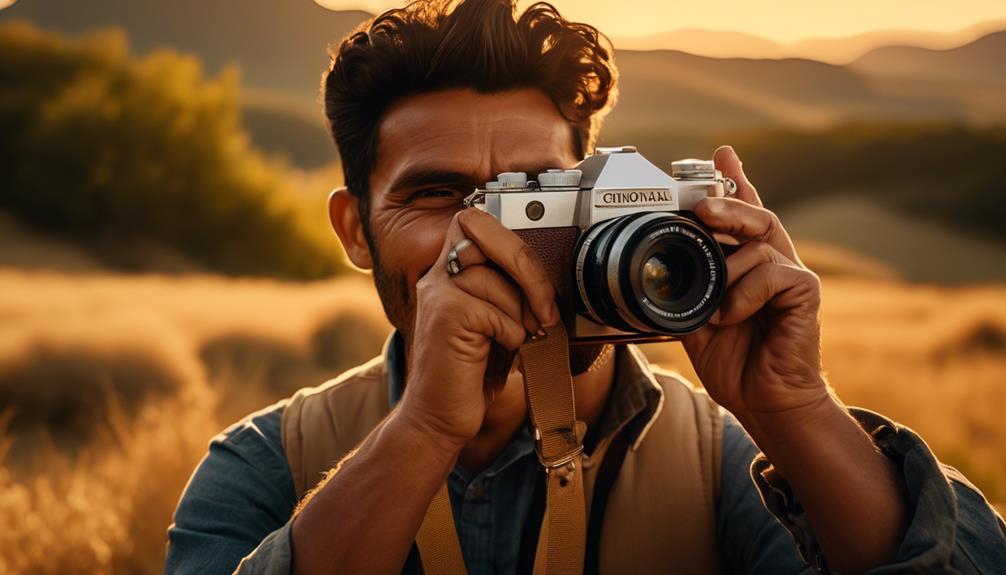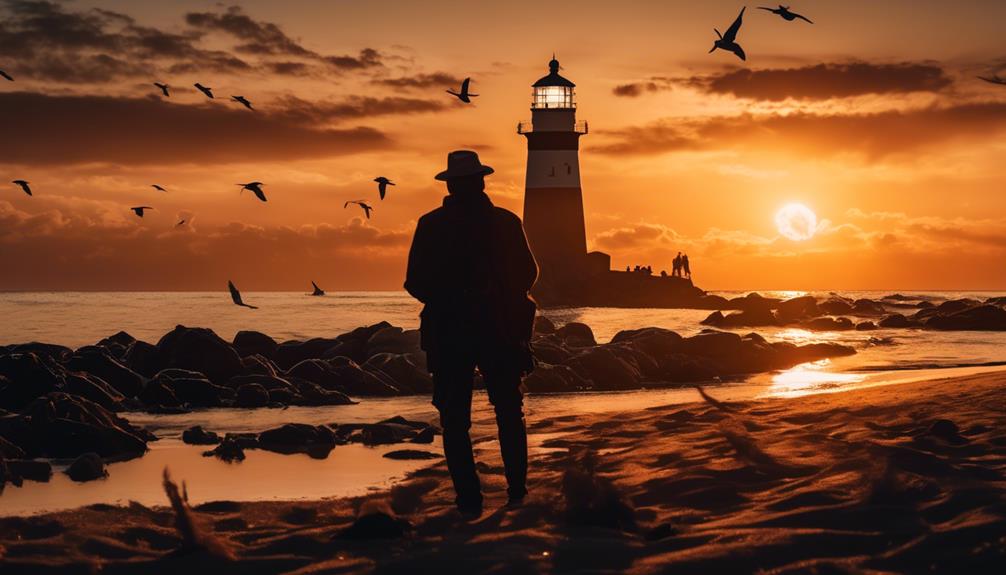Please note this post may contain affiliate links picked by me (Jay) that I have deemed may be of interest or relevant to you the reader of this.
These links do not affect the cost of the thing if you decide to purchase but i may get a little money if you choose to purchase.
For more information on my affiliate link policy click here.
As I stood on the edge of a bustling street, camera in hand, I couldn't help but notice the captivating scene unfolding before me. The vibrant colors, the raw emotions, the stories waiting to be told – all of it beckoned me to capture this moment through my lens.
It was in that very moment that I realized the power of storytelling imagery in improving my photo skills. Every click of the shutter became an opportunity to weave a narrative, to transport the viewer into a world of their own.
But how does one truly harness this power? How can we go beyond just taking pretty pictures and create images that truly speak to the heart?
Join me as we explore the art of storytelling through photography, and unlock the secrets to capturing moments that leave a lasting impact.
Key Takeaways
- Visual storytelling uses imagery and narrative structure to connect with the audience.
- Composition techniques like leading lines and unconventional angles can highlight emotions in photos.
- Lighting plays a crucial role in setting the mood and evoking specific emotions.
- Capturing candid moments that tell a story requires observation, patience, and anticipation.
Understanding the Power of Visual Storytelling
Visual storytelling is a captivating art form that allows us to communicate and connect with others on a deeper level through the power of imagery. It combines the use of visuals, such as photographs or videos, with a narrative structure to evoke emotions, convey messages, and engage the audience. Understanding the power of visual storytelling is essential for photographers and artists who want to create impactful and meaningful images.
One of the key aspects of visual storytelling is the use of various techniques to effectively convey a story or message. These techniques include composition, lighting, color, and perspective. By carefully considering these elements, photographers can guide the viewer's attention, create a mood, and enhance the overall narrative of the image. For example, using leading lines can lead the viewer's eyes towards a specific subject, while playing with light and shadow can evoke different emotions.
The impact of storytelling imagery is undeniable. It has the ability to capture the viewer's attention, evoke emotions, and create a lasting impression. When a photograph tells a story, it becomes more than just a visual representation; it becomes a powerful tool for communication. Storytelling imagery allows us to share our experiences, perspectives, and emotions with others, bridging the gap between different cultures, backgrounds, and languages.
Innovation in visual storytelling techniques is constantly evolving. With advancements in technology, photographers have more tools at their disposal to push the boundaries of creativity. From virtual reality to interactive storytelling, the possibilities are endless. By embracing these innovations, photographers can engage their audience in new and exciting ways, creating immersive experiences that leave a lasting impact.
Incorporating Emotion in Your Photos
Capturing the essence of emotion in your photos brings depth and resonance to your visual storytelling. By expressing feelings and evoking empathy, you can create a powerful connection with your audience.
Here are four techniques to incorporate emotion into your photos:
- Composition: Framing your subject in a way that highlights their emotions can have a profound impact. Use leading lines, rule of thirds, or unconventional angles to draw attention to the feelings you want to convey.
- Lighting: The right lighting can enhance the mood and evoke emotions in your photos. Experiment with natural light, shadows, or dramatic lighting to create a sense of intimacy, melancholy, or joy.
- Color: Colors have the power to evoke specific emotions. Play with color palettes to create a visual narrative that resonates with your audience. Warm tones can evoke feelings of comfort and happiness, while cool tones can convey calmness or sadness.
- Timing: Capturing the decisive moment can amplify the emotion in your photos. Anticipate and be patient, waiting for the perfect moment to press the shutter. Whether it's capturing a tear rolling down someone's cheek or a burst of laughter, timing is crucial in expressing genuine emotion.
Mastering Composition Techniques for Narrative Imagery
As a photographer, mastering composition techniques is essential for creating compelling narrative imagery that captivates your audience. One of the key elements of composition is creating depth in your photos. By incorporating techniques such as leading lines, foreground/background relationships, and the rule of thirds, you can add a sense of depth and dimension to your images.
Leading lines are powerful tools that guide the viewer's eye through the photo, creating a sense of movement and depth. Whether it's a winding road, a flowing river, or a row of trees, these lines draw the viewer's attention into the image, making it more engaging and dynamic.
Foreground/background relationships also play a crucial role in creating depth. By placing a prominent subject in the foreground, you can create a sense of scale and perspective. This technique allows the viewer to feel as if they're a part of the scene, immersed in the story you're trying to tell.
Utilizing color is another effective way to enhance the narrative in your imagery. Colors have the power to evoke emotions and set the mood of your photos. By carefully selecting and manipulating colors, you can create a visual language that supports the story you're trying to convey. For example, warm colors like red and orange can evoke feelings of warmth and passion, while cool colors like blue and green can create a sense of calmness and tranquility.
Mastering composition techniques and utilizing color effectively can take your narrative imagery to the next level. By creating depth and using color strategically, you can engage your audience, evoke emotions, and tell compelling stories through your photographs. So, grab your camera, experiment with different techniques, and let your creativity shine through your narrative imagery.
Using Lighting to Enhance Your Storytelling Photos
Now that we've explored the art of composition and the power of color in narrative imagery, let's shed some light on how to use lighting to enhance your storytelling photos. Lighting plays a crucial role in photography, as it can completely transform the mood and atmosphere of an image. By understanding how to balance exposure and create the right mood with lighting, you can take your storytelling photos to the next level.
Here are four key techniques to consider when using lighting in your storytelling photos:
- Natural Light: Harness the power of natural light to create a soft and ethereal atmosphere. The golden hour, just after sunrise or before sunset, provides a warm and magical glow that adds depth and emotion to your photos.
- Artificial Lighting: Experiment with artificial lighting to add drama and intrigue to your storytelling photos. Play with different types of light sources, such as candles, fairy lights, or even a simple desk lamp, to create unique and captivating effects.
- Shadows and Silhouettes: Use shadows and silhouettes to evoke mystery and suspense in your storytelling photos. By strategically placing your subject in front of a light source, you can create striking and dramatic shapes that leave a lasting impression on your audience.
- Light Painting: Get creative and use light painting techniques to add a touch of magic to your storytelling photos. By using a long exposure and a handheld light source, you can create whimsical patterns and trails of light that bring your stories to life.
Capturing Moments That Tell a Story
What makes a moment truly captivating and able to tell a story?
In my experience as a photographer, I've found that storytelling through color and capturing candid moments are two essential elements.
When we think about storytelling through color, we often associate different hues with specific emotions or moods. By using color effectively, we can convey the atmosphere and evoke certain feelings in our viewers. For example, warm tones such as reds and yellows can create a sense of warmth and happiness, while cool tones like blues and greens can evoke a more serene or melancholic mood. In this way, we can use color to enhance the narrative of our photographs and guide the viewer's interpretation.
Capturing candid moments is another powerful way to tell a story through photography. These are the unposed and unplanned moments that capture genuine emotions and interactions. They're the moments that reveal the essence of the subject or the event being photographed. Candid moments have an authenticity that staged or posed shots often lack. They allow the viewer to feel a connection with the people and the story being portrayed.
To capture these moments, it's important to be patient, observant, and ready to click the shutter at the right time. Being present in the moment and anticipating the action can lead to capturing those raw and compelling photographs that truly tell a story.
Frequently Asked Questions
What Is the Importance of Visual Storytelling in Photography?
Visual storytelling in photography is of utmost importance because it allows me to harness the power of narrative imagery. By creating a visual narrative through my photos, I'm able to engage my audience on a deeper level, evoking emotions and capturing their attention.
Through storytelling, I can convey a message, tell a story, or provoke thought. It adds depth and meaning to my photographs, transforming them from mere images into powerful stories that resonate with viewers.
How Can Emotions Be Effectively Conveyed Through Photos?
When it comes to conveying emotions through photos, visual storytelling is key. It allows me to capture moments that speak directly to the heart. By using composition, lighting, and timing, I can create images that evoke powerful feelings in the viewer.
Each element of the photo becomes a brushstroke in the painting of emotions. From a tear rolling down a cheek to a smile that lights up a room, my goal is to capture the essence of the human experience through the lens of my camera.
What Are Some Composition Techniques That Can Enhance Narrative Imagery?
When it comes to enhancing narrative imagery, there are a couple of composition techniques that can really make a difference.
The first one is the rule of thirds, which involves dividing your frame into nine equal parts and placing your main subject along the intersection points. This adds visual interest and balance to your photo.
Another technique is using leading lines, which are lines that guide the viewer's eye towards the main subject or through the entire image. This creates a sense of depth and helps tell a story within your photo.
How Can Lighting Be Used to Enhance the Storytelling Aspect of Photos?
Using lighting techniques is a powerful way to enhance the storytelling aspect of photos.
For example, by strategically using shadows, we can create a sense of mystery and intrigue in our images.
By casting shadows on a subject's face, we can create a sense of depth and emotion, adding layers to the narrative.
This technique allows us to convey a story and evoke emotions in the viewer, making the photo more engaging and impactful.
How Can Photographers Capture Moments That Effectively Tell a Story?
To effectively capture moments that tell a story, photographers must focus on capturing emotions and utilizing visual storytelling techniques.
By understanding the narrative they want to convey, photographers can compose their shots in a way that evokes specific emotions from viewers.
Techniques like framing, leading lines, and selective focus can guide the viewer's eye and enhance the storytelling aspect of the image.
With practice and experimentation, photographers can create powerful and engaging visual stories that leave a lasting impact.
Conclusion
In the vast world of photography, the ability to tell a story through imagery is a skill that can elevate your work to new heights. By understanding the power of visual storytelling, incorporating emotion, mastering composition techniques, using lighting effectively, and capturing moments that truly speak, you can create photos that not only capture a moment but also transport viewers to another world.
So, grab your camera and let your storytelling skills shine through your lens. Adventure awaits!


